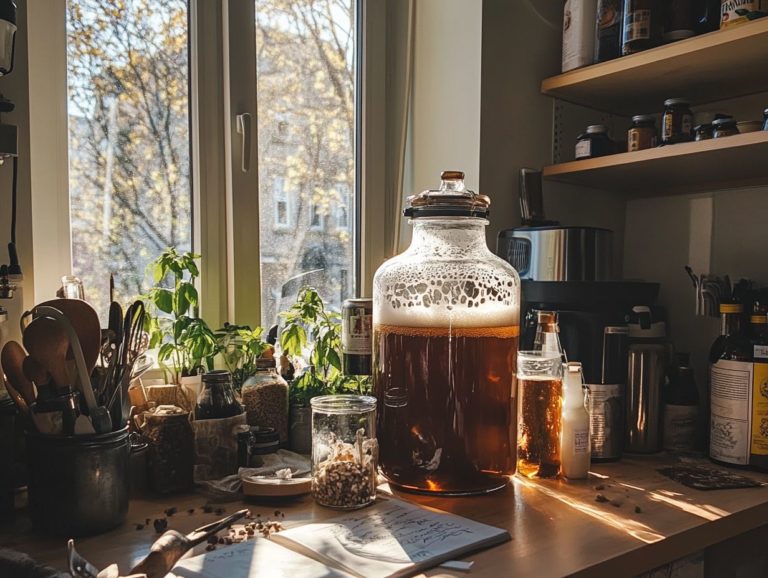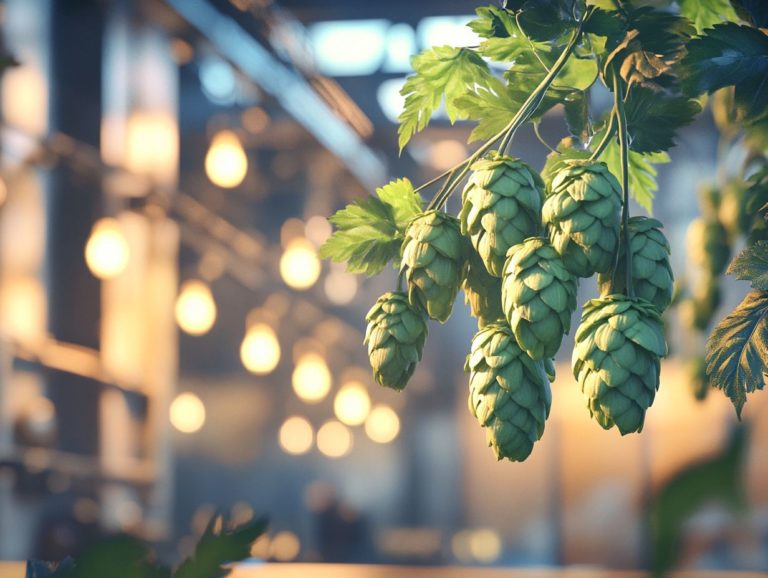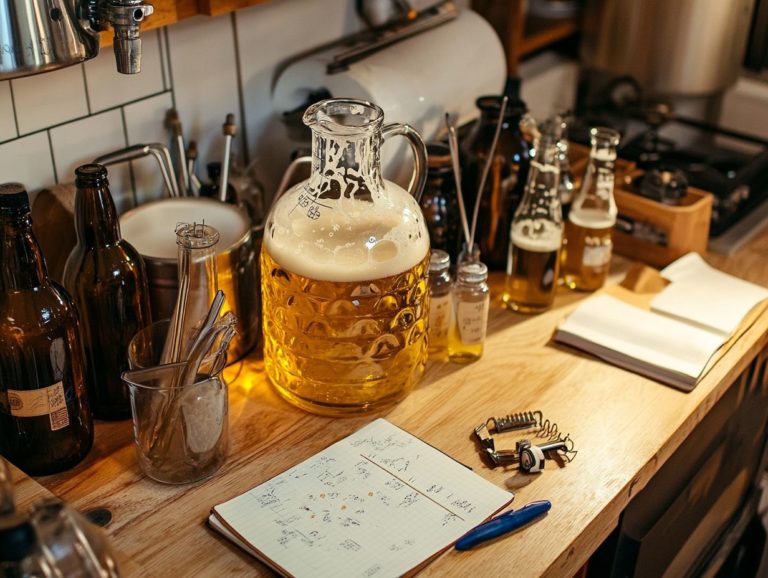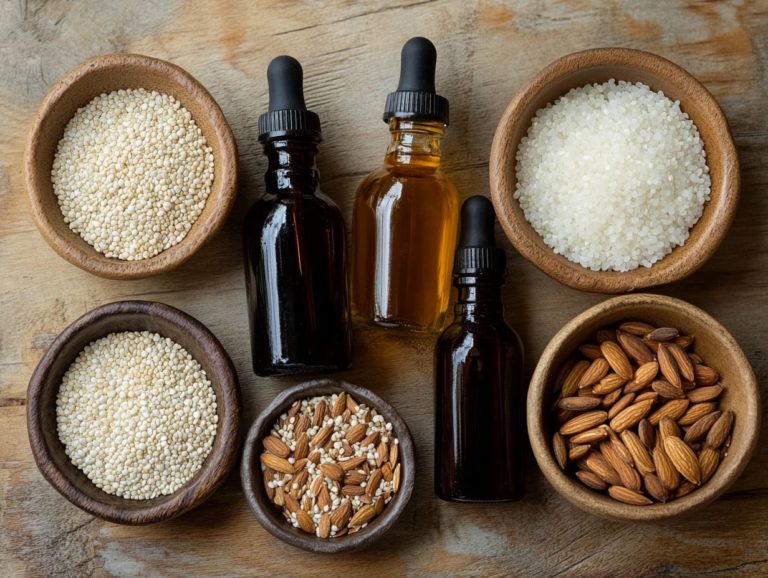What Are the Most Common Home Brewing Questions?
Homebrewing is an exhilarating and fulfilling hobby that empowers you to craft your own distinctive beers in the comfort of your home. Get ready to embark on an exciting brewing adventure!
Whether you re a complete novice or possess some brewing knowledge, this guide encompasses everything you need to start brewing. From essential equipment and ingredients to a detailed step-by-step brewing process, you ll uncover the secrets to creating your ideal brew.
This guide also addresses common brewing questions you may have, providing you with the tools to troubleshoot and refine your technique, including advice on beer clarity and fermentation time.
Contents
- Key Takeaways:
- What is Home Brewing?
- What Equipment Do I Need for Home Brewing?
- What Are the Optional Equipment for Home Brewing?
- What Ingredients Do I Need for Home Brewing?
- What Are the Basic Ingredients for Home Brewing?
- What Are the Specialty Ingredients for Home Brewing?
- What Are the Steps for Home Brewing?
- Step 1: Sanitizing Equipment and Preventing Infections
- Step 2: Boiling the Wort
- Step 3: Cooling the Wort
- Step 4: Adding Yeast
- Step 5: Fermentation
- Step 6: Bottling or Kegging
- What Are the Most Common Home Brewing Questions?
- Frequently Asked Questions
- What Are the Most Common Home Brewing Questions?
- What equipment is needed to start home brewing?
- What ingredients are essential for home brewing?
- How long does the home brewing process take?
- Can I use regular kitchen equipment for home brewing?
- What is the difference between all-grain and extract brewing?
- What are some common mistakes to avoid when home brewing?
Key Takeaways:
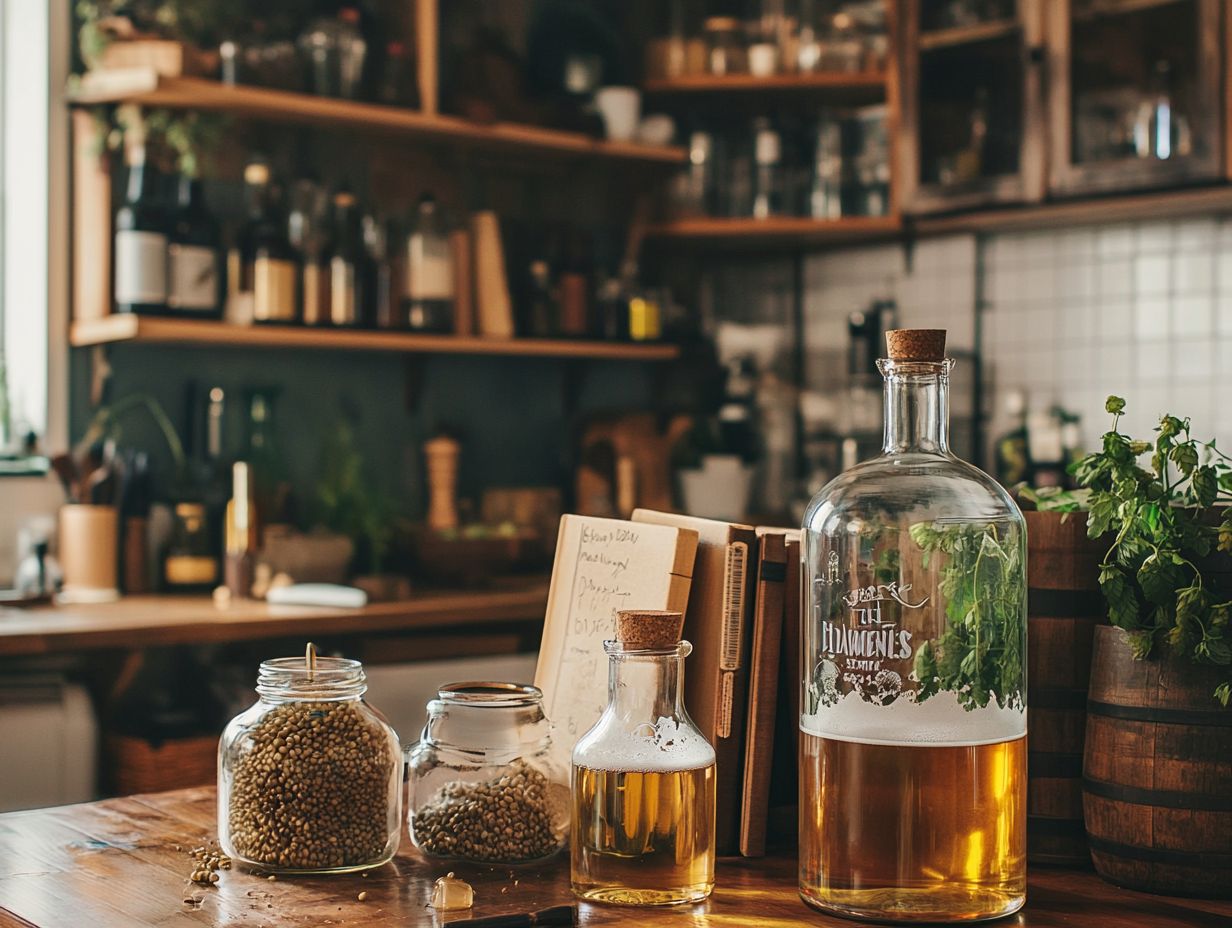
- Home brewing requires essential brewing equipment such as fermentation vessels and optional tools like a wort chiller and pH meter.
- You need basic ingredients for home brewing, such as water, malt, hops, and yeast. Specialty ingredients can be added for unique flavors.
- Key steps in the home brewing process include sanitizing equipment, boiling and cooling the wort, adding yeast, and bottling or kegging the finished product.
What is Home Brewing?
Home brewing is both an art and a science that invites you to create beer right in the comfort of your own home. It s an exciting opportunity for you to experiment with a variety of ingredients, fermentation methods, and styles.
This creative journey involves mastering brewing techniques that enable you to craft unique beer recipes that truly reflect your personal tastes while unraveling the intricacies of the fermentation process and the significance of brewing ingredients like malt and hops.
As you gain experience in homebrewing, you can explore the complexities of yeast management, navigate starting gravity calculations, and fully engage with the brewing process, including DIY brewing. This ultimately leads to the production of high-quality craft beers tailored specifically to your preferences.
What Equipment Do I Need for Home Brewing?
To embark on the rewarding journey of home brewing, you’ll need a collection of essential brewing equipment to ensure a successful fermentation process and produce high-quality homebrew.
From fermentation vessels that create a controlled environment to hydrometers for accurately measuring specific gravity, each piece of equipment plays a pivotal role in the brewing experience. Securing the right yeast starter and dry yeast is crucial for maintaining yeast health.
Bottling supplies and beer kits will serve you well, offering convenience as you delve into a variety of beer styles and beer recipes.
What Are the Essential Equipment for Home Brewing?
Essential equipment for your home brewing journey includes a fermentation vessel, which is crucial for facilitating the fermentation process while safeguarding your wort from unwanted infections. You ll also want a hydrometer to measure the starting gravity and monitor the fermentation progress.
Preparing a yeast starter from dry yeast is vital for ensuring optimal yeast health, and having the right bottling equipment is necessary for proper beer storage and carbonation. Beyond these essentials, an airlock is pivotal. It allows gases to escape while preventing contamination, creating a stable environment where your yeast can truly thrive.
You can t underestimate the importance of a good brewing kettle; it enables precise temperature control during the boiling process, which is essential for extracting rich flavors and bitterness from the hops. Additionally, a reliable thermometer is essential for monitoring temperature at various stages, helping you maintain the integrity of your brew.
Together, these tools create a harmonious brewing experience, allowing you to concentrate on crafting unique flavors and achieving the desired characteristics in your final product.
What Are the Optional Equipment for Home Brewing?
Essential equipment forms the backbone of your brewing endeavors. Optional tools can elevate your home brewing experience, granting you greater control over brewing techniques and the quality of your beer.
Beer kits simplify the brewing process for novices. Kegging systems offer a streamlined approach to beer storage and carbonation no bottling required.
Off-flavor training kits are invaluable for identifying and correcting potential brewing mishaps. Advanced fermentation vessels enhance your brewing by providing improved temperature control and minimizing the risk of contamination.
Incorporating a grain mill into your setup allows for freshly milled grains, significantly enhancing flavor and efficiency. A wort chiller is a smart investment, helping you reach the ideal fermentation temperature quickly, leading to cleaner and more consistent results.
A pH meter gives you precise insights into your water chemistry. These tools can significantly enhance your brewing experience and help you craft exceptional beers.
What Ingredients Do I Need for Home Brewing?
The ingredients you choose for home brewing are essential to crafting unique beer flavors and styles. The primary components in your brewing process malt, hops, yeast, and priming sugar each play a critical role.
Malt serves as the source of fermentable sugars essential for producing alcohol. Hops add a layer of bitterness and aroma, perfectly balancing the malt’s sweetness.
Yeast is essential for fermentation, transforming those sugars into alcohol and carbon dioxide. Priming sugar is crucial for achieving carbonation during the bottling phase.
When combined, these ingredients work in harmony to create a flavorful and well-balanced homebrew that reflects your personal touch.
What Are the Basic Ingredients for Home Brewing?
The essential ingredients for home brewing include malt, hops, yeast, and wort, each playing a critical role in the beer brewing process.
Malt serves as the backbone of your brew, often sourced from a variety of barley or specialty malts like caramel or chocolate. These choices contribute unique flavors and colors that enrich the character and complexity of your final product.
Hops come from various strains and serve a dual purpose. They provide the bitterness that balances out the sweetness of the malt while enhancing the aroma with delightful floral, citrus, or earthy notes.
Your selection of yeast strains whether you opt for ale or lager is paramount, as it significantly influences the fermentation profile. This choice results in distinct flavor characteristics and mouthfeel that can truly elevate your brew.
Finally, wort, produced through the mashing and boiling of malt, is the liquid extracted from the malted grains. It serves as the sweet liquid foundation that captures the essence of your ingredients, setting the stage for the enchanting transformation into beer.
What Are the Specialty Ingredients for Home Brewing?
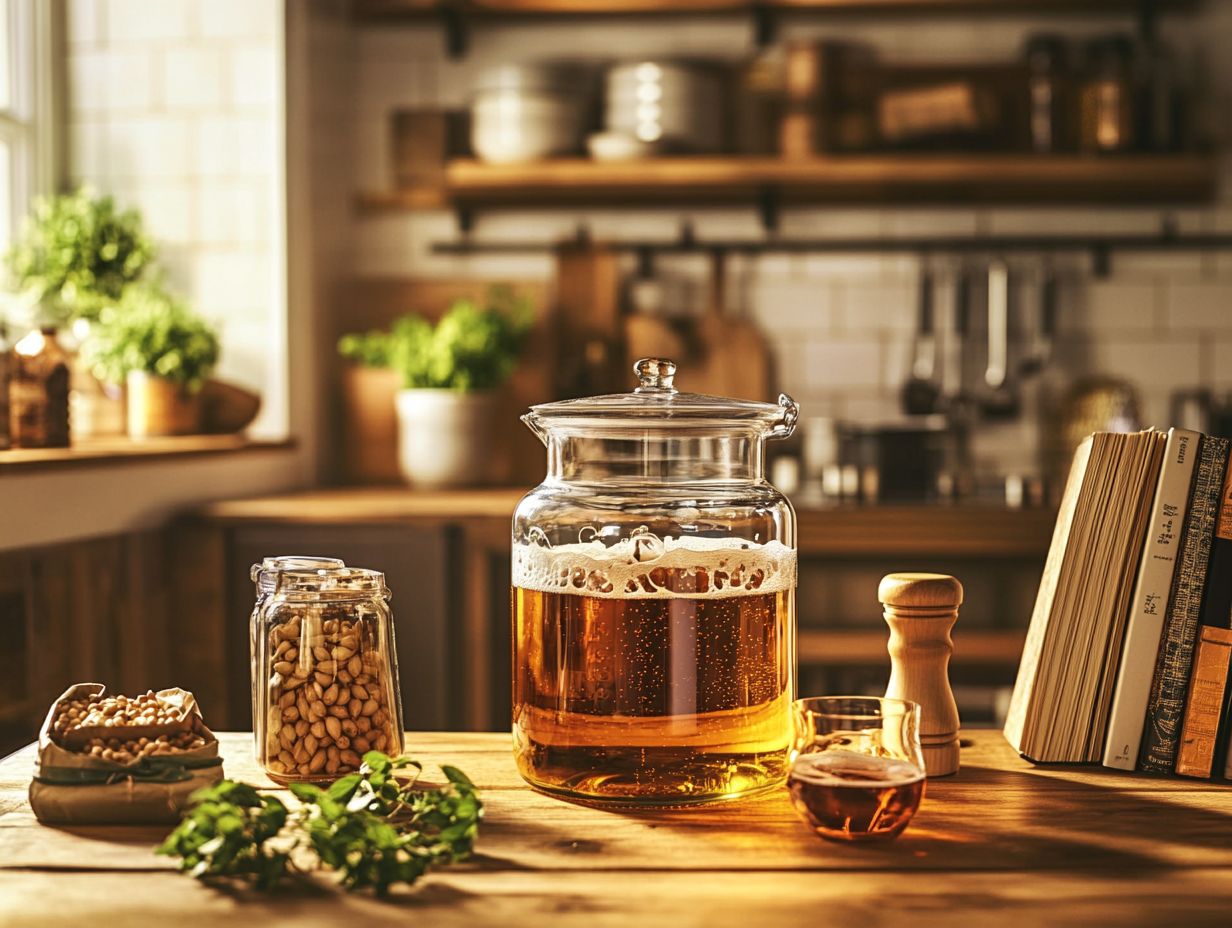
Specialty ingredients in home brewing elevate your beer recipes. They impart unique flavors, aromas, and characteristics, setting different beer styles apart.
Think about specialty malts that contribute distinct color and flavor profiles. You can also use fruits and spices to enhance fermentation flavors. Incorporating adjuncts like corn or rice can alter the mouthfeel and overall taste of your brew.
By embracing these specialty ingredients, you can experiment with craft beer and create innovative, distinctive brews that reflect your personal flair. This enhances your overall brewing artistry.
Imagine incorporating items like honey, herbs, or even exotic grains to push the boundaries of traditional beer crafting. For example, adding chamomile or coriander might lead to a refreshing and aromatic wheat beer.
On the other hand, using smoked malts could transform your creation into a robust porter with complex layers of flavor. Think about how these ingredients will transform the aroma and flavor of your beer!
It s essential to consider how these specialized ingredients influence the fermentation process itself. This presents a fantastic opportunity to explore unique brewing techniques. These creative choices are exciting and can take your brewing to the next level!
They are crucial for anyone eager to push the limits of their brewing artistry and produce compelling, one-of-a-kind floral, spicy, or even savory notes that will tantalize adventurous palates.
What Are the Steps for Home Brewing?
The home brewing process is a careful process that needs your attention to detail. This attention is crucial to achieve successful fermentation and exceptional beer quality.
Addressing common concerns such as infections and off-flavors is vital for success. It all starts with sanitizing your equipment, a crucial step to ward off infections that could ruin your brew.
Once everything is pristine, you ll move on to boiling the wort. In this step, you ll capture the rich flavors from the malt and hops.
It is essential to cool the wort quickly to the ideal temperature range for fermentation before introducing the yeast. This action kicks off the fermentation process!
Finally, once fermentation wraps up, you ll bottle or keg your beer for carbonation and storage. This prepares it for the moment of enjoyment, ensuring proper beer conditioning for the best flavor and mouthfeel.
Step 1: Sanitizing Equipment and Preventing Infections
Sanitizing your equipment is the first and one of the most crucial steps in the home brewing process. It effectively prevents unwanted infections that can compromise the quality of your beer.
By applying a suitable sanitizer to all equipment that will come into contact with the wort or beer, you create a sterile environment. This sets the stage for successful yeast fermentation and the development of the flavors you desire.
Adhering to proper sanitation practices protects the integrity of your brewing efforts. It also safeguards the time and resources you invest.
Techniques such as soaking carboys, fermenters, and brewing utensils in a no-rinse sanitizer can dramatically reduce the risk of bacteria or wild yeast spoiling your hard work. Keeping a clean brewing area and handling equipment with sanitized hands further elevates the overall quality of your final product.
Consistency in these sanitation practices directly influences the fermentation process. This allows yeast to thrive, transforming the wort into the rich, well-balanced beers that enthusiasts crave. Ultimately, a vigilant approach to sanitation not only enhances your brews but also fosters a deeper appreciation for the art of brewing.
Step 2: Boiling the Wort
Boiling the wort is a key step in brewing. It mixes sugars from the malt with hops, creating a balance of flavor.
This is where the magic begins. The timing of your hop additions can dramatically change your beer s profile.
Longer boiling times increase bitterness, while shorter durations help preserve aromatic oils. Boiling also removes unwanted bacteria.
The technique you use shapes the beer’s character, influencing how drinkers experience its unique flavors.
Step 3: Cooling the Wort
Cool the wort quickly after boiling. This step is essential for achieving the ideal fermentation temperature.
You can use a wort chiller to bring the temperature down to a yeast-friendly range, usually between 65 F to 75 F.
Consider methods like immersion chillers or plate chillers. Each method optimizes heat exchange and minimizes contaminants.
Rapid cooling is critical. If the wort is too warm, yeast can produce off-flavors. If it s too cool, fermentation may slow down.
By cooling the wort effectively, you create a healthy environment for the yeast and enhance the brew’s quality.
Step 4: Adding Yeast
Adding yeast kicks off your fermentation. Introduce a healthy yeast starter or dry yeast to the cooled wort.
Pitch yeast at the right temperature to promote optimal fermentation and avoid off-flavors.
Choosing the right yeast strain is crucial. Each strain affects flavor and aroma, elevating your final product.
Pay attention to temperature control. Each strain thrives within specific ranges to avoid sluggish fermentation.
Nurturing fermentation dynamics leads to high-quality results that showcase your beer’s intended style.
Step 5: Fermentation
Fermentation is an essential stage in your home brewing journey, where yeast works its magic by consuming the sugars in the wort to produce alcohol and carbon dioxide. This process has a profound impact on the quality of your beer.
You need to watch your fermentation vessel closely to ensure the yeast remains healthy and to prevent any unwanted off-flavors. Depending on the beer style and the yeast strain you choose, fermentation time can range from just a few days to several weeks.
As you monitor this phase, look for signs that your brew is fermenting properly. Bubbling in the airlock, a frothy krausen forming on the surface, and a gradual decrease in specific gravity which is a measure of the density of the liquid compared to water are all indicators of a healthy fermentation process.
It’s crucial to understand that factors like temperature and oxygen levels significantly influence yeast performance and overall fermentation success. By paying close attention to these indicators, you can assess the health of your yeast.
Remember, healthy yeast is your ally in achieving efficient fermentation. It enhances the flavor profile, clarity, and stability of your final beer, ensuring that your brew meets and exceeds your quality expectations.
Step 6: Bottling or Kegging
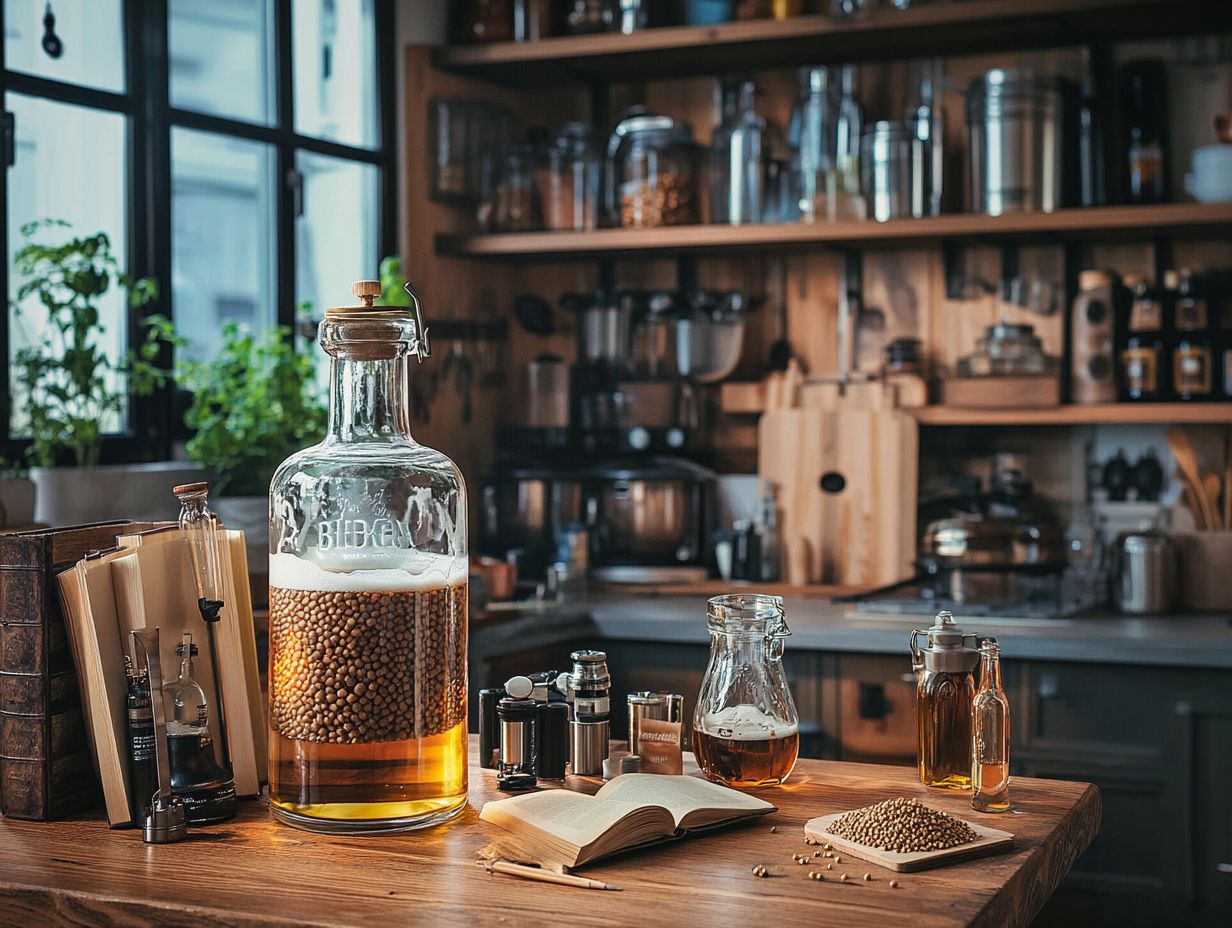
The final step in your home brewing journey involves the important task of bottling or kegging your beer. Here, you ll add priming sugar to carbonate your brew before it undergoes the crucial process of beer conditioning.
This step allows your beer to develop its flavors and effervescence, transforming it into a refreshing craft beer that s ready for both storage and enjoyment.
By introducing priming sugar, you initiate a secondary fermentation in the sealed environment of the bottle or keg, producing carbon dioxide. This carbonation is vital, as it influences not only the texture and mouthfeel but also the overall aroma and taste profile of your finished product.
Once this stage is complete, beer conditioning begins, allowing the flavors to meld and mature, significantly enhancing your drinking experience. Don t overlook proper storage conditions keeping your beer in a cool, dark place is equally important. This ensures stability and preserves the quality of your craft brews over time. This diligent care ultimately allows you to savor the fruits of your labor.
What Are the Most Common Home Brewing Questions?
As home brewing steadily rises in popularity, you may find yourself with a plethora of questions about the fermentation process, the right equipment, and techniques that can elevate your brewing skills.
It’s crucial to address common concerns, including fermentation time, troubleshooting issues with your homebrew, and the best practices for achieving those desired beer flavors.
By actively seeking answers to these inquiries, including common home brewing myths, you can build your confidence and significantly enhance the quality of your beer.
1. How long does it take to brew beer at home?
The time it takes to brew beer at home can vary significantly based on the style of beer and the brewing process, with fermentation time being a critical factor that shapes the final product. Generally, you can expect the brewing process to take anywhere from a few weeks to several months, depending on how long fermentation, conditioning, and carbonation take.
For example, a typical ale might enjoy a primary fermentation of about one to two weeks before it s ready for bottling. In contrast, a lager often demands a longer fermentation period, sometimes extending to three weeks or more, thanks to its cooler fermentation temperatures.
Once fermentation is complete, your beer will move into the conditioning phase, which can last an additional two weeks to several months. This step is essential for developing flavors and achieving the clarity and stability you desire.
Certain styles, such as IPAs, are best enjoyed fresh but still benefit from a brief conditioning period to mellow out hop bitterness. This nuance in timing allows you to tailor the brewing process to achieve the specific characteristics you aim for in your creation.
Are you ready to see how your beer turns out? Experiment with different techniques and enjoy the journey!
2. Can I use tap water for home brewing?
Using tap water for home brewing is a common concern among enthusiasts, and rightly so water quality can profoundly influence both the brewing process and the final quality of your beer. While some tap water might be acceptable, it’s crucial to consider factors like mineral content and chlorine levels. These elements can impact not only the fermentation process but also the flavor profile of your finished brew.
To truly assess whether your tap water is suitable for brewing, conduct a detailed evaluation of its composition. This means analyzing the mineral balance, particularly the levels of calcium, magnesium, and bicarbonate. All of these are vital for enzyme activity and overall brewing success. Using a hydrometer can help you measure the gravity of your wort, which is essential for understanding fermentation efficiency.
It’s also important to test for the presence of chlorine or chloramine. These can introduce unpleasant tastes that compromise the quality of your beer. Off-flavor training can help you identify and address these issues. If your tap water is lacking in necessary minerals or contains unwanted compounds, you have options. You can make adjustments through techniques such as carbon filtration or by adding mineral salts.
By optimizing your water for brewing, you can significantly elevate the taste and aroma of your final product, contributing to a delightful drinking experience.
3. How do I know when my beer is ready to drink?
Determining when your homebrew is ready to savor involves a few key factors centered around fermentation time and the carbonation process. A well-fermented beer will have achieved its desired alcohol content and flavor profile. You can assess carbonation by checking the pressure in your bottles or kegs and evaluating the clarity of the beer.
Using a hydrometer to check the final gravity can also help determine if your beer has fully fermented. To ensure quality, take a moment to evaluate the aroma; it should present a pleasing bouquet devoid of any unpleasant tastes. The beer should also offer a delightful mouthfeel, indicated by a balanced taste that doesn t overwhelm your palate.
As carbonation develops, watch for those small bubbles rising steadily. They enhance both the texture and the pour. A good rule of thumb is to wait at least two weeks after bottling to allow flavors to meld and carbonation to stabilize. Remember, bottling with the right amount of priming sugar is crucial for achieving optimal carbonation.
When all these signs align, dive into your homebrew with confidence, knowing it has matured into a delightful drinking experience!
4. How do I troubleshoot problems with my homebrew?
Troubleshooting issues with homebrew may feel overwhelming as a new brewer. However, identifying common concerns early can significantly mitigate problems and enhance your future batches. Issues like unpleasant tastes, infections, or poor carbonation typically arise from specific stages of the brewing process. Understanding these nuances is essential for elevating the quality of your beer.
Consulting resources like the BJCP Fault List and advice from beer writer David Ackley can provide valuable insights. By familiarizing yourself with typical pitfalls, you’ll be better equipped to navigate the intricate world of fermentation and extraction.
Take unpleasant tastes like diacetyl, for example; they’re often linked to yeast stress and can spoil a batch if left unaddressed. Maintaining proper temperature control during fermentation and ensuring your yeast is healthy are vital steps to avoid these pitfalls. Using a yeast starter can also help ensure vigorous fermentation and minimize the risk of unpleasant tastes.
Infections, another common challenge, usually result from unsanitized equipment. Establishing a strict sanitation routine can dramatically reduce these risks. Mastering carbonation requires a solid understanding of the priming process and making the necessary adjustments to sugar levels. This ensures a smooth and enjoyable drinking experience.
Understanding the fermentation temperature range and maintaining it can further help in preventing infections and ensuring healthy fermentation. By implementing these troubleshooting strategies, you can refine your brewing skills and consistently produce better results. Utilizing resources like the Institute of Brewing and Distilling can provide you with advanced techniques and knowledge.
5. Can I reuse yeast for multiple batches?
Reusing yeast for multiple batches of homebrew is a savvy move that experienced brewers often embrace. Not only does it save you time and money, but it also helps keep your yeast healthy and viable. Hydrating dry yeast correctly before reuse can also contribute to its health and viability.
When done right, reusing yeast can lead to consistent fermentation and noticeably improved beer quality, as long as you harvest, wash, and store it properly after each brew. Understanding the starting gravity and monitoring it can help you gauge fermentation progress and make necessary adjustments.
Knowing the specific yeast strain and its unique characteristics can elevate your brewing experience. This knowledge allows you to craft the desired flavors and aromas in your final product. To truly maximize the benefits, it’s essential to handle the yeast with care and minimize contamination during the harvesting process.
After fermentation, giving the yeast time to settle before siphoning off the beer is crucial for isolating those healthy yeast cells. Store your harvested yeast in a clean, airtight container at a cool temperature to maintain its viability for future batches. This step is crucial in maintaining yeast health for consistent brewing results.
By following these best practices, reusing yeast not only becomes a more economical option but also enhances your brewing skills and improves your end results. This practice is often recommended in various brewing techniques for better fermentation outcomes.
Try reusing yeast in your next brew and share your results with fellow brewers!
Frequently Asked Questions
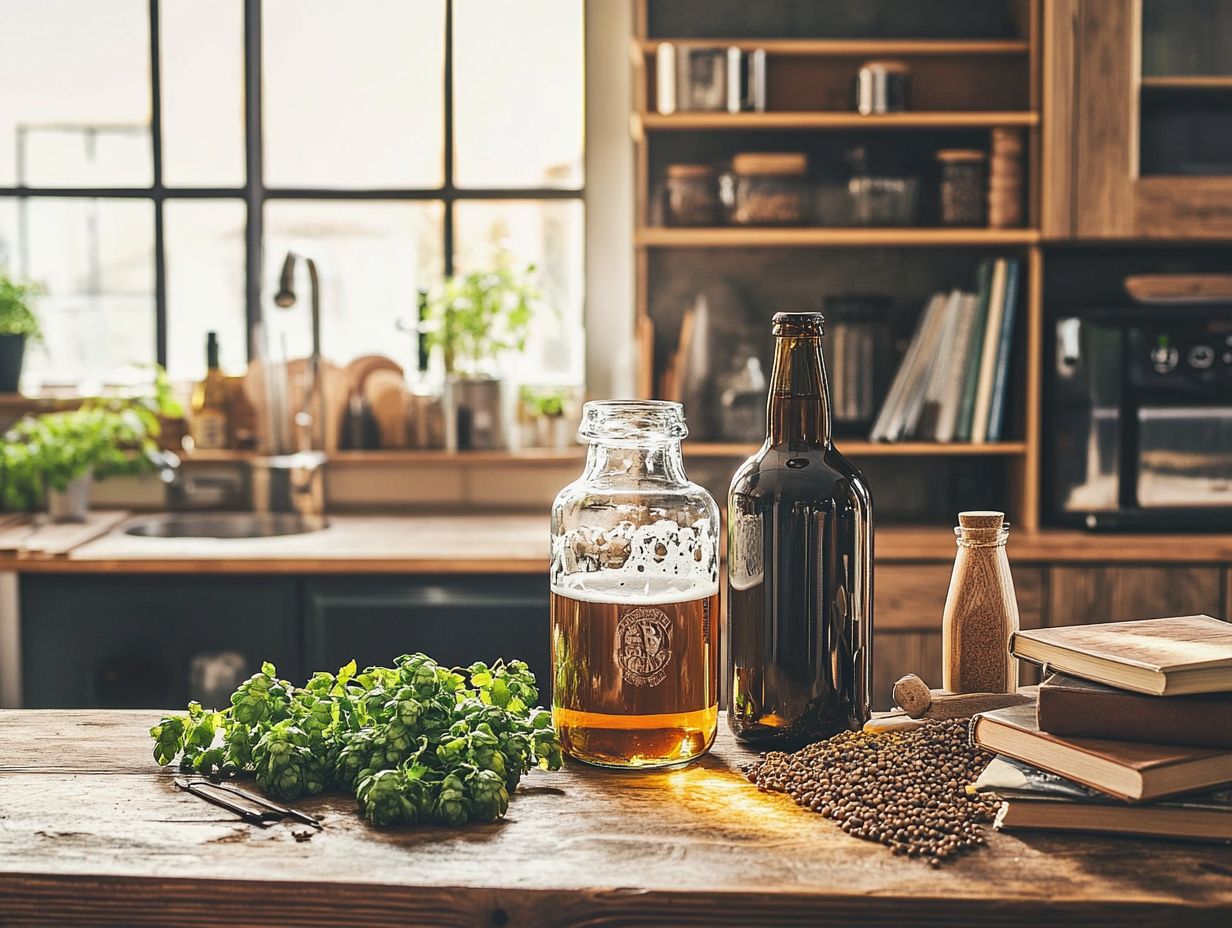
What Are the Most Common Home Brewing Questions?
Common questions vary depending on skill level. Examples include:
- How can I ensure proper beer clarity?
- What are the ideal conditions for beer storage?
- What brewing techniques work best for different beer styles?
What equipment is needed to start home brewing?
To start home brewing, you will need basic equipment such as a brewing kettle, fermentation vessel, and bottling equipment. Additional items like a thermometer, hydrometer, and airlock may also be necessary. Beer kits can be a great way to get started with DIY brewing, providing you with all essential components in one package.
What ingredients are essential for home brewing?
The essential ingredients for home brewing are:
- Malt
- Hops
- Yeast
- Water
These four components form the foundation for brewing any type of beer. Using high-quality brewing ingredients ensures better flavors and overall beer quality.
How long does the home brewing process take?
The home brewing process can take anywhere from 2 to 6 weeks, depending on the type of beer being brewed and the fermentation and bottling processes involved. Understanding the fermentation time for different beer styles can help you plan your brewing schedule more effectively.
Can I use regular kitchen equipment for home brewing?
While some basic kitchen equipment can be used for home brewing, it is recommended to invest in proper brewing equipment designed specifically for brewing beer to achieve the best results. Investing in quality brewing equipment can help you overcome common challenges and achieve better beer quality.
What is the difference between all-grain and extract brewing?
All-grain brewing involves using malted grains to create the wort, while extract brewing uses pre-made malt extract. All-grain brewing is typically considered the more advanced method, but both can produce quality beer. Each method requires different techniques and offers unique advantages depending on your brewing goals.
What are some common mistakes to avoid when home brewing?
Some common mistakes to avoid when home brewing include:
- Not properly cleaning and sanitizing equipment
- Not controlling fermentation temperature
- Not following recipe instructions accurately
These common concerns can be mitigated by following advice from experienced brewers and staying informed about best practices in home brewing.

